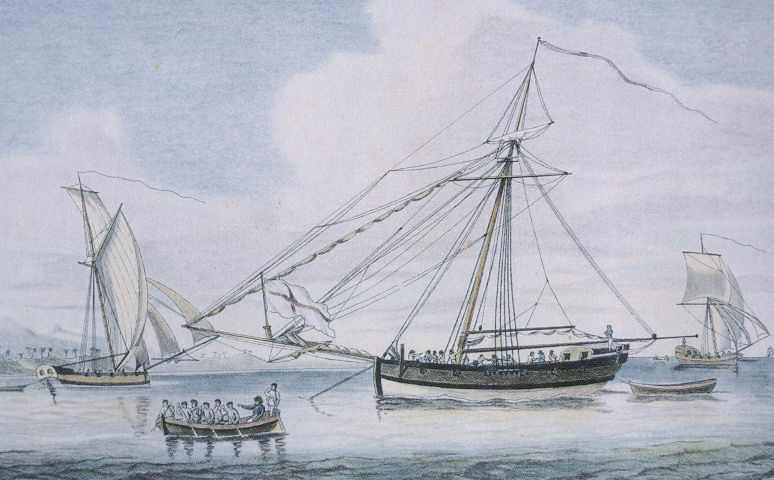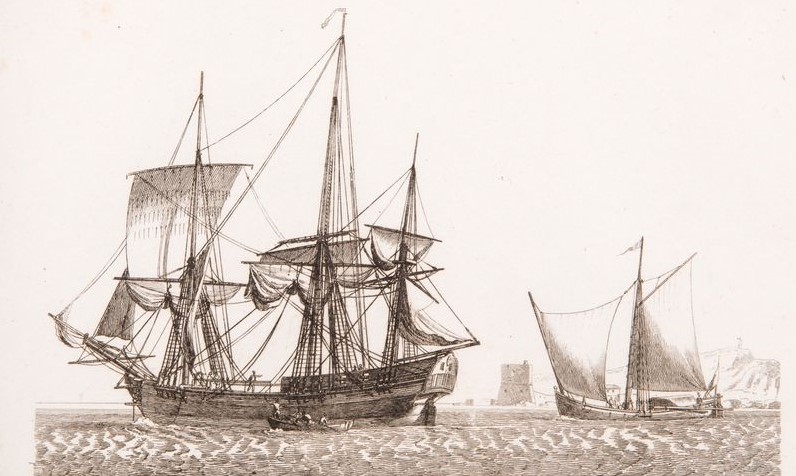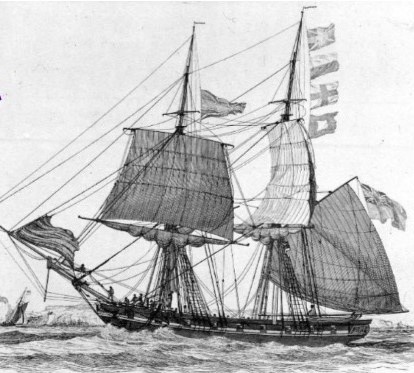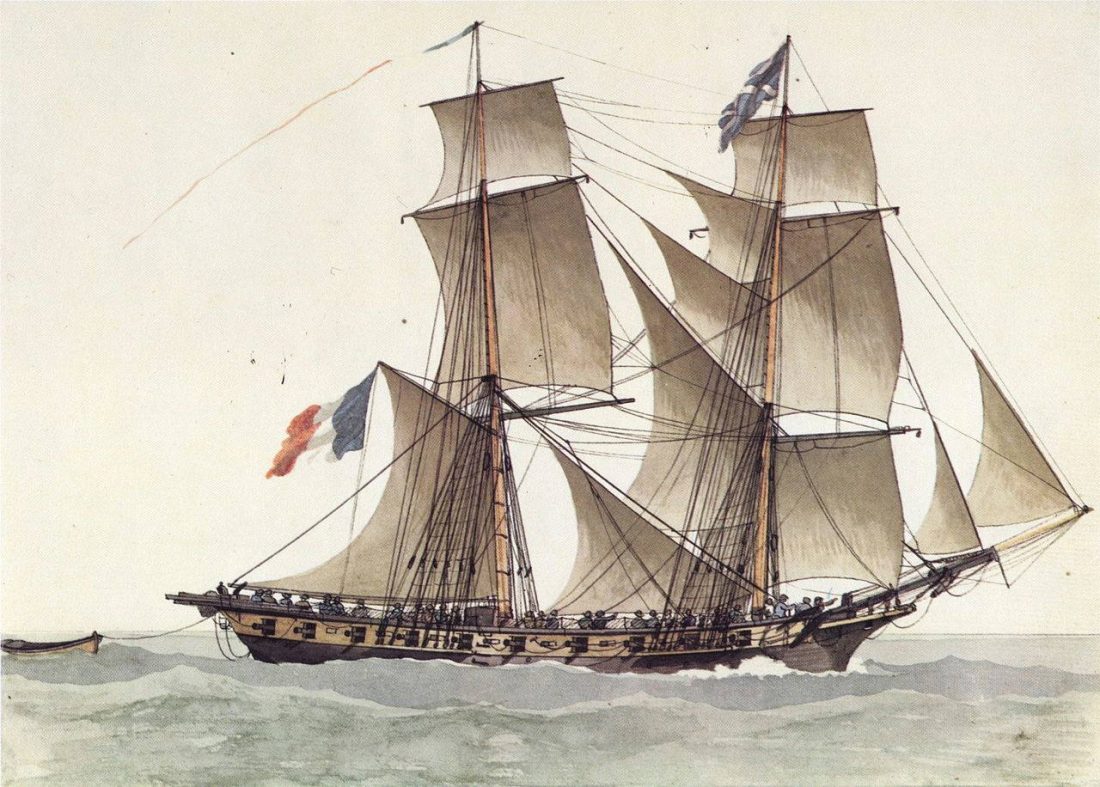Privateer in action: the Ellen 1780
Privateers receive little attention in accounts of naval warfare right up to the time when the practice was banned by international Paris Declaration of 1856, which only the United States, among major nations, omitted to sign. Such privately-owned ships were authorised by a “letter of marque” to prey on enemy shipping. Usually small, and lightly armed enough to intimidate and capture merchant shipping, but not to fight warships, they tended to be small fast vessels. In an era before radio and radar, their victims were unable to raise the alarm as to their plight, so preventing them warning other ships in the vicinity of the danger. In the course of the Great Age of Fighting Sail, roughly 1700 to 1815, they were responsible for the capture of thousands, if not tens of thousands, of merchant ships, many of them small coastal traders. These actions that are almost universally forgotten today. In possession of a fast and suitably armed vessel, crewed by experienced seamen, the owner, or sometimes syndicate of owners, of a privateer was well placed to make a handsome profit in wartime. One such ship, the Ellen, captained by a James Borrowdale, was to demonstrate in 1780 just how effective such a ship could be.

Privateers could be small, such as this Baltimore sloop, and generally preyed on vessels of their own size and lightly armed, if at all
Described as “an armed merchantman”, the Ellen, of Bristol, seems to have engaged in trading as well as holding a letter of marque – her privateering was likely to have been on an opportunistic basis as an adjunct to her other business. Armed with eighteen six-pounders, and with a crew of sixty-four, half of them boys and landsmen on their first voyage, she set out in March 1780 for the West Indies. The American War of Independence was underway, with French and Spanish forces allied to the Americans. James Borrowdale had given passage to an army captain, a Captain Blundell of the 79th Regiment who was going out to join his unit in Jamaica and he undertook to train sixteen of the Ellen’s crew to act as marines. This would be an augmentation of the ship’s potency as marines were likely to be valuable in boarding operations, or to pouring down small-arms fire on opponents’ decks.

Small Neopolitan merchantman – typical of the sort of target that privateers might dream of
A month out, on April 16th, the Ellen sighted a vessel to windward, apparently of her own general size, and possibly as well armed. Unwilling to risk a fight, Borrowdale crowded on all his canvas and ran. He did however ready his guns and their crews, while Blundell mustered amateur marines. The stranger gained on the Ellen however, firing a gun as an indication that she should heave to, and ran up the Spanish ensign. Seeing that it was impossible to avoid a fight, Borrowdale shortened sail, and hoisted American colours as a ruse to gain time and to draw the enemy in close before opening fire. Each of his guns had been loaded with as bag of grape-shot as well as solid round-shot — a measure likely to particularly effective against sails and cordage. The guns were to be kept trained on the Spaniard as she neared.

HMS Orestes – a British sloop in revenue service, a vessel of the size and armament ideal for profitable privateering service
When the enemy was within hailing distance Borrowdale hauled down the American colours and ran up the British. This was simultaneous with Ellen’s first broadside and a volley of musket-fire from Blundell’s contingent. The unexpected and vigorous attack appears to caught the Spaniards unprepared – their captain may have been deceived by the false colours up to the last moment and seems not to have made sufficient preparations for action. In the confusion he lost control of his vessel’s handling. She fell off from the wind and passed under the Ellen’s lee, thereby allowing a broadside from that side also to be poured into her. Hit by two broadsides, the Spanish captain decided to run, pursed by the Ellen and slowed by damage aloft. The Ellen now ran alongside and attacked again. This time the Spanish defence was more determined and the two vessels lay yardarm to yardarm, blasting each other for an hour and a half. Both seem to have directed their fire at masts, sails and cordage – indication that they were both intent on taking a prize rather than on wrecking it. Only when his ship had been completely disabled aloft did the Spanish captain strike his colours.

A French brig-of-war, painted by Antoine Roux (1765-1835). The Spanish Santa Anna Gratia would probably have looked similar.
Captain Borrowdale found himself in possession of the Santa Anna Gratia, a regular Spanish Navy sloop-of-war that mounted sixteen six-pounders and several swivel guns. He had a crew of 104, of whom seven were killed and eight wounded. This compared with one killed and three wounded on the Ellen, the low butcher’s bill reflecting both captain’s focus on masts and rigging.
The Ellen proceeded to Port Royal in Jamaica with her prize in company, entering with British colours surmounting the Spanish – one of the few instances of a privateer taking on and vanquishing a regular warship.
s
 1866: it’s four years since France invaded Mexico and set up a new ‘Mexican Empire’ with a puppet emperor imported from Europe but armies loyal to the republican government still resist. In a land devastated by battles, atrocities and reprisals, the tide of war is now turning in favour of the republic’s ‘Juarista’ supporters. France recognises that the war is unwinnable and evacuation inevitable, but first there will be bitter rearguard actions and old scores to settle.
1866: it’s four years since France invaded Mexico and set up a new ‘Mexican Empire’ with a puppet emperor imported from Europe but armies loyal to the republican government still resist. In a land devastated by battles, atrocities and reprisals, the tide of war is now turning in favour of the republic’s ‘Juarista’ supporters. France recognises that the war is unwinnable and evacuation inevitable, but first there will be bitter rearguard actions and old scores to settle.
Britain is neutral in this conflict, but large British interests – railway and mining enterprises – are at risk as the war-front edges ever closer. Investors in London are demanding British action to protect their assets.
Sub-Lieutenant Nicholas Dawlish is serving on the Pacific Station in the gunvessel HMS Sprightly. She, and her resourceful captain, are tasked with taking ‘appropriate’ action to guarantee the safety of these interests. The situation is complex – not only Juarista, French and Imperial Mexican forces but bandit groups, a volunteer Belgian Legion and ex-Confederate mercenaries are involved. And there’s a powerful ironclad, flying Imperial Mexican colours, commanded by an Austrian aristocrat who’s desperate for glory.
Dawlish is plunged into deadly action by land and sea and, with fluency in French and Spanish, he’ll be his captain’s right-hand man in a web of political intrigue, treachery and greed in which a single mistake can end both their careers.
But for Dawlish there’s something worse, a heart-breaking encounter with a figure from his past to whom he’s linked by a solemn promise that he can’t fulfill. What follows will be torment for his emotions and his conscience . . .
Available in Large Paperback and Kindle formats. Kindle Unlimited subscribers can read at no extra charge. Kindle version available for pre-order. Click the marketplaces below for ordering details:
United States Canada
United Kingdom Australia & New Zealand
Below are the twelve Dawlish Chronicles novels published to date, shown in chronological order. All can be read as “stand-alones”. Click on the covers below for more information. All are available in Paperback or Kindle format and can be read at no extra charge by Kindle Unlimited Subscribers.
Six free short stories are available for download to your Kindle. Access them by registering for the Dawlish Chronicles mailing list – just click on the banner below. You’ll be kept updated on new books and will receive other free stories at intervals.




